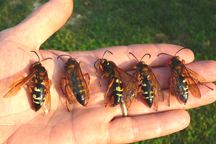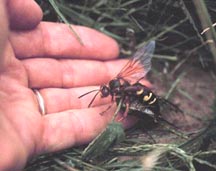Sphecius speciosus
| Sphecius speciosus | ||||||||||||
|---|---|---|---|---|---|---|---|---|---|---|---|---|

Male (left) and female (right) of Sphecius speciosus . |
||||||||||||
| Systematics | ||||||||||||
|
||||||||||||
| Scientific name | ||||||||||||
| Sphecius speciosus | ||||||||||||
| ( Drury , 1773) |
Sphecius speciosus (colloquially English Eastern Cicada Killer , also: cicada killer or the cicada hawk ) is a grave wasps -Art from the kind Sphecius in the family of Crabronidae . The species occurs in the eastern part of the United States , in Central America and Mexico , its range is east of the closely related species Sphecius grandis (" Western Cicada Killer ") in the western United States. They are large, solitary wasps. As the name suggests, the brood of wasps feeds mainly on singing cicadas , which are hunted by the mother animals and stored in the nest. In North America, the animals are sometimes called sand hornets , although strictly speaking they do not belong to the hornets belonging to the Vespidae family. As natural enemies of the cicadas, the wasps can be viewed as beneficial insects, as they reduce damage to trees caused by oversized cicada populations.
The latest research on this species was carried out by Howard Ensign Evans .
features
Adult wasps are 1.5 to 5 cm long, robustly built with hairy, reddish and black zones on the thorax (middle part), as well as reddish-brown markings and yellow stripes on the segments of the abdomen. The wings are brownish. The average wing length of the females is between 2.5 and 3 cm. On the surface, the color scheme is similar to that of other wasps or hornets . The females are significantly larger than the males and they are among the largest species of wasps found in the eastern United States.
As is typical for the relationship, the sexes can be distinguished by the number of whiplash members of the antennae (ten in the female, eleven in the male). In addition, females carry two greatly enlarged flattened spurs on the rails of the hind legs, which they use to dig the nest.
Differentiation between the species of the genus
The distinction between S. speciosus and the other four American species of the genus Sphecius ( S. convallis , S. hogardii , S. grandis , S. spectabilis ) is not easy. The distinction is often uncertain, as there are great individual differences within the species. Charles W. Holliday and Joseph R. Coelho issued a new key in 2004 to distinguish the Sphecius species, which mainly relates to the drawing of the tergites.
Way of life and habits

Solitary wasps (such as the Eastern Cicada Killer) differ greatly in behavior from social wasps such as hornets, real wasps and field wasps . The Cicada killers almost invariably use their sting to stun their prey and hardly defend their nest. They also won't sting unless you grasp them firmly. The adult animals feed on nectar and other vegetable juices.
The animals appear in summer, usually from late June and early July, and die in September or October, and accordingly appear in a period of 60 to 75 days. The large females usually fly in search of flight over lawns looking for suitable places to dig their burrows, or go hunting for cicadas in trees and bushes.
The males often stay in groups and fight hard for the breeding areas from which they themselves hatched. They usually observe anything that moves or flies near them. Often one sees several males fighting air battles and whirling through the air until one of the wasps gives up. The aggressive behavior of the males is comparable to the behavior of the male Carpenter Bees . In either species, the males pose no threat to passers-by, however terrifying and threatening their behavior may be. Male wasps only fight with their own species and cannot sting at all.
The earth-dwelling wasp occurs in well-draining, sandy soils to loosely clayey soils, over open areas as well as over grass areas, street banks or even on pedestrian paths and terraces. Several females sometimes share a burrow but dig their own nest cells. A typical burrow is 25 to 50 cm deep and about 1.5 cm in diameter. To dig, the females first loosen the soil with their pines and then scrape the earth outside with their hind legs. The excess earth is piled up as a wall around the building and a trench is shoveled to the building entrance. The animals also nest in planters, flower pots, in flower beds or under bushes, etc. The nests, however, are usually in full sun where there is less vegetation.
The females then hunt cicadas, which they stun with their venom. Then the wasp grabs the cicada with its belly upwards and flies with it to the burrow; the wasps often prey on cicadas that can reach twice their body weight. After one or more cicadas have been placed in the nest, the female lays an egg on one of the cicadas and seals the cell with soil. The eggs for males are laid on a single cicada, while the eggs for females are always given several cicadas. New nest cells are dug several times from the main tunnel and a burrow can contain more than 10 cells. The larva hatches within one to two days and feeds on the cicadas. They complete their development within about 2 weeks and hibernate as a pupa in an earth-covered cocoon. Hatching takes place in the cells and takes 25 to 30 days to complete. There is only one generation each year and no adult animals that overwinter.
The wasp is often attacked by parasitic ant wasps ( Dasymutilla occidentalis ), which are also known as "cow killer wasps". They lay their eggs in the cells of the Cicada killer and as soon as the Cicada killer larvae pupate, the parasite larva consumes the pupa.
Contact with people
Although Cicada Killers are large, the females are usually not aggressive and rarely sting unless they are handled, kicked, or caught in clothing. Stitches are described as harmless (" not much more than a pinprick "). Males aggressively defend their residence against rivals, but have no sting. Although they appear to attack almost anything that moves in their territory, the males are only looking for females. This search is often seen as an attack by humans, but neither males nor females land on humans to sting. Females can only sting if they are roughly handled. Males can only scratch their abdomen with a sharp thorn. However, both sexes are good at biting, but can barely penetrate human skin. Generally they will run away as soon as they are disturbed.
Similar species
The genus Sphecius is distributed worldwide. 21 species are known and there are three more species in North America:
- Sphecius convallis (" Pacific cicada killer "), western USA and Mexico
- Sphecius grandis (" Western cicada killer "), central and western USA and Mexico
- Sphecius hogardii (" Caribbean cicada killer "), Florida and the Caribbean
DNA barcoding data from different Specius species revealed a common haplotype for Specius speciosus and some individuals of Sphecius convallis . According to the authors of the study, this could indicate either a lack of species differences or a recent hybridization with introgression , but it could also simply be a result of the recent species separation with still imperfect genetic splitting ( lineage sorting ) of the species.
The bespectacled cicada killer ( Sphecius spectabilis (Taschenberg, 1875) ) occurs in Argentina , Bolivia , Brazil , Chile , Colombia , French Guiana , Paraguay , Suriname, and Venezuela .
There are other genera of cicada-hunting digger wasps of the Crabronidae such as Liogorytes (South America) and Exeirus ( Australia ).
Individual evidence
- ^ Howard Ensign Evans, Kevin M. O'Neill: The Sand Wasps: Natural History and Behavior. Harvard University Press 2007: 37-43. ISBN 978-0-674-02462-5
- ^ Jon Hastings: Sexual-size dimorphism in Western cicada killer wasps, Sphecius grandis (Hymenoptera: Sphecidae). In: Transactions of the Kentucky Academy of Science. vol. 50, 1-2: 1-5.
- ^ Joseph R. Coelho: Sexual size dimorphism and flight behavior in cicada killers. In: Oikos 79 (2), 1997: 371-375 doi: 10.2307 / 3546021 JSTOR 3546021 .
- ^ Charles W. Holliday; Joseph R. Coelho: Improved Key to New World Species of Sphecius (Hymenoptera: Crabronidae). In: Annals of the Entomological Society of America. 99 (5), 2006: 793-798 doi : 10.1603 / 0013-8746 (2006) 99 [793: IKTNWS] 2.0.CO; 2
- ^ Joseph R. Coelho: Cicada killer control. ( Memento of the original from August 28, 2008 in the Internet Archive ) Info: The archive link was automatically inserted and not yet checked. Please check the original and archive link according to the instructions and then remove this notice. .
- ↑ Jon M. Hastings, Patrick J. Schultheis, Maggie Whitson, Charles W. Holliday, Joseph R. Coelho & Angela M. Mendell: DNA barcoding of new world cicada killers (Hymenoptera: Crabronidae). In: Zootaxa vol. 1713, 2008: 27-38.
Web links
- Sphecius is a comprehensive list of taxonomic information on the genus.
- Prof. Joe Coelho's cicada killer page
- Dick Walton's Solitary Wasps Page with outstanding video clips of Sphecius speciosus and other digger wasps
- Australian cicada killers , genus Exeirus (info page at the Ozcam website)
- Image of Australian cicada killer wasp Exeirus lateritius (at the CSIRO Entomology website)
- Eastern cicada killer on the University of Florida / Institute of Food and Agricultural Sciences Featured Creatures website
- fact sheet from the Ohio State University Extension.





